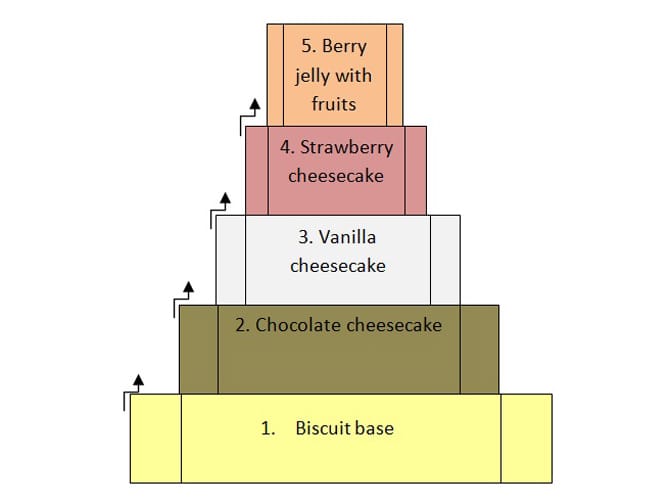Writing an essay, choose a credible structure used by thousands of students around the world. This format is called 5-paragraph essay, and has a couple of simple rules to follow.
- 🎂 How is an essay like a cake?
- 🗼 The 3 pillars of a consistent 5-paragraph essay
- 🍰 Feature of the cake layers
- 📑 Create a refined essay with our writing hacks
- 🕔 Draft an astonishing essay with a 5-minute outline
- 📝 Write a killer paper using our 5-paragraph essay example as a guideline
- 🅰 Getting an A+ grade for 5 paragraphs writing is easy!
The best part about this type of outline is that it fits any topic. Whether you’re creating a paper on technology, friendship, or global warming, you can use this structure and get a fantastic logical essay with statements, details, and conclusions.
In this article, you’ll know all you need to turn your ideas into an excellent piece of academic writing.
Can’t wait?
So, let’s start!
🎂 How is an essay like a cake?
Did you know that you can effectively unleash your creative capacity and astonish everyone with your talent by creating just 5 paragraphs? Writing a 5-paragraph essay can be easier and faster than baking a 5-layer cake if you know the secret ingredient. Keep reading to get to the essence of 5-PE mastery.
You may be wondering: “What does this kind of essay have in common with a 5-layer cake?”
In fact, both are well-structured. All their components are coherent and interrelated.
- They start with a solid background (in the essay, an introduction = in the cake, a firm biscuit base).
- They contain 3 middle layers (3 body paragraphs = 3 cheesecake layers).
- They finish with a summary that wraps it all up (conclusion = berry jelly with fruits).


🗼 The 3 pillars of a consistent 5-paragraph essay
The 5-paragraph essay writing method helps inexperienced writers to state their ideas within the given topic in the most clear and logical way. Once you understand and get used to this writing formula, you’ll become more comfortable with it. The basic elements of a 5-paragraph essay are 3 pillars you will come to lean on.
So you’ve got a five-paragraph essay assignment.
What does 5 mean here? Why not 2 or 7?
In fact, it consists of 5 paragraphs, made up of 3 main parts:
- Introduction
- Body
- Conclusion
Here are the key insights to each component of a correctly structured essay:
🍰 Feature of the cake layers
Our “cake study comparison” reveals the following distinctive features of the cake layers:
- Introduction: the solid biscuit base of the cheesecake sets the overall style of your culinary masterpiece. Its sweet and melting taste makes it the most promising part for the end-consumer.
- Main body: 3 magnificent cheesecake layers, each one different in taste and color, each complementing the creamy flavor of the basic cheesecake part of the cake.
- Conclusion: a berry jelly with fruits to conclude. Its sour-sweet taste complements the main body and contrasts with the cheesecake, contributing to the inimitable aftertaste.
As for the 5-paragraph essay conclusion, its “aftertaste” is exactly what will stay with your readers after they put down your paper. So carefully consider the structure of your essay to make sure all its parts are coherent and balanced. Take a look at some essay examples to have a better idea of how it can look like.
Now you know about structure, which is the secret ingredient that makes your essay convincing and your cake delicious.
📑 Create a refined essay with our writing hacks
Whatever project you have to complete ‒ creating a 5-paragraph essay or a 5-layer cake ‒ the perfectionist in you may not feel fully satisfied until your masterpiece is flawless. Harness these useful tips if you need to create an engaging essay that your readers will enjoy reading and talking about.
- Organization
- To make an effective start, you first need to get organized.
- Analyze your task in detail.
- Determine your purpose.
- Think about your step-by-step plan.
- Outline
- Don’t get lost in the detail. Before you set out with the actual writing, map it out. Otherwise, you may get lost.
- Divide your future essay into sections; develop each piece separately and incrementally.
- First figure out how to make an outstanding outline, and then you can go ahead and start your essay-building process.
- Writing style
- Develop your unique writing style and stick to it.
- Start strong by grabbing the reader’s attention. Aim to keep it until you reach your final point. Stay powerful and convincing.
- Use active voice instead of passive whenever possible.
- Don’t let your reader fall asleep: play with your English, vary sentence structures, avoid repetition, sharpen and diversify your vocabulary when you revise the text.
- Brainstorm to search for the best ideas that support your case. Include only the arguments that are effective and that you have some knowledge of, otherwise you won’t do a good job of presenting them.
- Writing introductory paragraphs on different topics can be very helpful. It will help set the tone for the paragraph, making it easier to write the supporting sentences. Moreover, seeing your pattern progress is always inspiring!
- Supporting ideas, examples and other details should all be relevant to the subtopic. It will help you and the readers to stay focused.
- Specific writing tips
- There are some other specific rules that you can use as a guide to creating an outstanding 5-paragraph essay.
- Don’t use abbreviations and contractions.
- Avoid casual language (it’s better not to begin sentences with “sure”, “well”, “yes” or “no”).
- Don’t use slang (there’s a big difference between academic writing and a message to your friend).
- Try not to begin your sentences with “There is/are”. For example, instead of “There is a need to edit the essay”, write “Essay editing is essential”.
- Don’t begin sentences with conjunctions (“and”, “but”, “for”, “yet”, “so”, “or”, “nor”).
- Avoid using phrases like “a lot”, “lots” and “lots of”. Think about replacing them with “many”, “most”, “much” or “often”.
- Avoid using exclamation points; stay more or less neutral in your writing.
- Essay revision
- Forget about your writing! Get some rest… and then read it again with fresh eyes. Polish and refine your essay as many times as you need to ‒ you won’t be sorry for spending time on it. Ask someone knowledgeable to review and criticize your essay as well – they may make suggestions that surprise you.
- Check your writing for spelling and grammar mistakes.
- Make sure your ideas flow logically.
- Avoid too much detail or wordiness.
- Be concise, specific and brief, but do give details and examples.
Also, make sure to check out free handout about essay writing.
🕔 Draft an astonishing essay with a 5-minute outline
Humans crave order. Anything else can lead them astray. A 5-paragraph essay outline is essential for those who want to create their short essay in the most effective and timely way. An essay outline will streamline your writing; it will also make you focus on the main topic and on the subtopics exposed in each separate part of the paper.
Have a look at our 5-paragraph essay writing outline for “How to Make Lemonade When Life Gives You Lemons”, and use it as an essay sample whenever you need inspiration for the framework of your own essay. It will take you just 5 minutes, and it will considerably save time when it comes to your own essay writing.
How to Make Lemonade When Life Gives You Lemons
📝 Write a killer paper using our 5-paragraph essay example as a guideline
🅰 Getting an A+ grade for 5 paragraphs writing is easy!
You will soon discover that it’s not that difficult to learn how to write a 5-paragraph essay that will hit the spot and win you the highest grade. Our tips for writing a good essay can help you to communicate your ideas clearly and effectively.
Think about all the possible 5-paragraph essay topics and select the one that’s best for you – that’s the one that will make five-paragraph essay writing interesting for you!
Good luck with your writing!
![How to Write a 5-Paragraph Essay [+Bonus Template]](https://ivypanda.com/blog/wp-content/uploads/2020/11/front-view-young-female-sitting-black-shirt-blue-jeans-writing-down-notes-thinking-yellow-736x491.jpg)



Breathtakingly amazing article!
Thank you for your feedback! We greatly appreciate it!
Thank you so much. It’ s really great and amusing explanation of how to write an essay.
You’re welcome, Doha! Glad you enjoyed the article.
Your essay writing system is very good.
Thank you so much!
Actually I have difficulties in the introduction of each type of essay, for example, the expository essay “developed by examples or developed by definition”. I need more explanations about each type, please.
Thanks for the feedback, Rawya! We will take into account your suggestion for our next post on essays.
Good tips! I think it can be useful for my writing.
Thanks for the feedback, Sophy!
You’ve got it in one. Couldn’t have put it better.
Glad you liked, Cherilynn!
I’m so grateful to have found this nugget because my students are struggling with essay writing. Thanks.
Thanks for your feedback, Justina! Glad you found my guide helpful 🙂